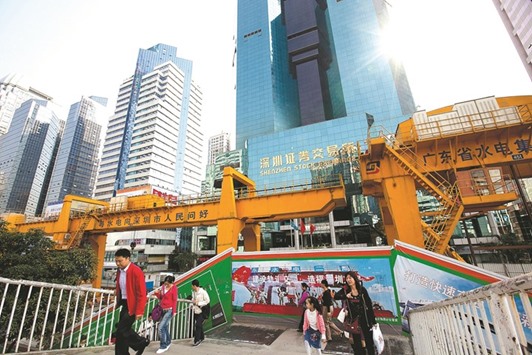As far as China’s stock market is concerned, the old economy is back in the driver’s seat.
Industrial, infrastructure and state-owned firms are powering gains in the Shanghai Composite Index this month, which climbed to the highest level since January on Tuesday. By contrast, a measure of Shenzhen-listed firms dominated by technology and high-growth stocks has barely budged, and is trading at the narrowest premium over the Shanghai index in at least six years.
It’s a scenario that calls into question the government’s pledge to shift the world’s second-largest economy from dependence on building a slew of bridges, railroads and skyscrapers to growth driven by individual consumption and innovative services companies.
Investors in the $6.5tn stock market are betting China’s top Communist Party officials, who are meeting in Beijing this week, will favour infrastructure projects and fiscal spending to put a floor under the slowest economic expansion in more than two decades. “The policy guidance this year is to switch from thematic investment to blue chips,” said Yang Delong, Shenzhen-based chief economist at First Seafront Fund Management Co. “Infrastructure and public-private partnership investment are being deployed to stabilise economic growth.”
China Railway Group and China Communications Construction Co have rallied more than 20% this month, driving up a gauge of industrial companies. The measure rose 7% in October, outpacing a 3.6% gain in the Shanghai Composite Index and a 1.5% advance in the ChiNext board.
Investors have been heartened by official data showing that income at industrial Corps jumped the most in three years in August and that total government spending rose to 1.98tn yuan in September - nearly 40% more than a month earlier.
The revival of old-economy industries illustrates the challenge China faces in meeting its growth target of 6.5-7% for this year. The nation’s broadest measure of new credit exceeded estimates in September to fuel stabilisation, while also escalating concerns over a property binge and the pace of debt expansion. The room for interest-rate cuts has been cramped by the yuan’s decline of 4.2% this year to a six- year low, as well as the PBoC’s attempts to reduce leverage in the financial system.
“There’s limited room for the government to resort to traditional monetary easing,” said Zhang Gang, a Shanghai-based strategist at Central China Securities Holdings. “Investors are betting the government will boost infrastructure investment to drive economic growth in the future. The sixth plenum might give more policy clarity.”
The Communist Party is holding an annual meeting of its 200-plus member Central Committee, a closed-door conclave called a plenum, in Beijing this week to discuss the direction policy should take. The ruling party usually releases a communique after the gathering to broadly sum up the decisions it has reached.
While South China Financial Holdings and Hengsheng Asset Management Co said they expect President Xi Jinping to take steps to make state firms and large industrial companies more efficient and profitable, small-cap technology stocks have fallen out of favour as valuations become stretched. Trading on the market, created in 2009 for smaller companies to raise funds, dropped to only a fifth of last year’s peak, while its 30-day volatility slid to a record low in September.
Dai Ming, a fund manager at Hengsheng Asset, said declines in the small-cap gauge’s valuation are unavoidable, and that this will “hamper the economic transition and innovation by slowing investment in new-economy areas.” He expects the measure’s valuation to drop to about 30 times earnings.
The ChiNext gauge trades at about 47 times reported earnings, compared with a multiple of 18 for the Shanghai Composite and about 13 for the Hang Seng Index. The small-cap board fell to the lowest level versus the Shanghai gauge since at least 2010, based on its price-to-earnings ratio.
“Investors want to position for a change in policies” toward more infrastructure spending, said Sam Chi Yung, a senior strategist at South China Financial in Hong Kong. “Traders sense there are more business opportunities in infrastructure-related, railway and construction industries. The rally can continue as long as the government’s policies remain favourable.”

People walk in front of the Shenzhen Stock Exchange building in China. The ChiNext gauge trades at about 47 times reported earnings, compared with a multiple of 18 for the Shanghai Composite and about 13 for the Hang Seng Index.


